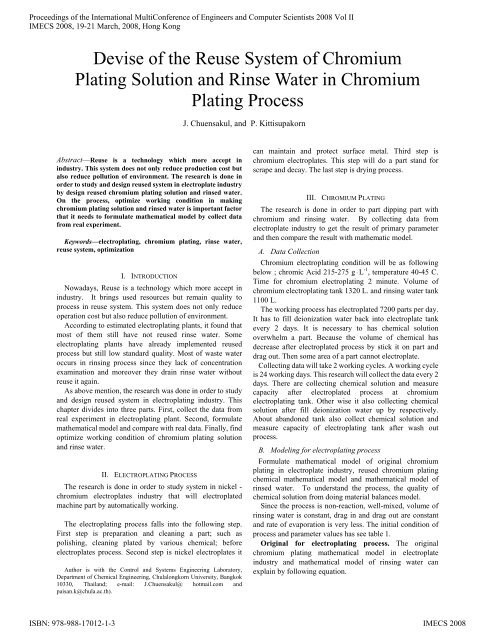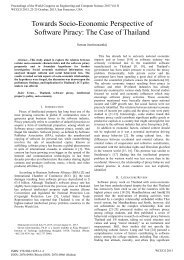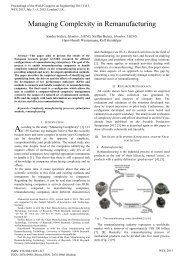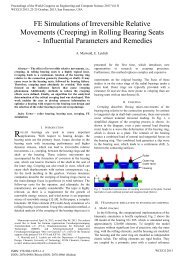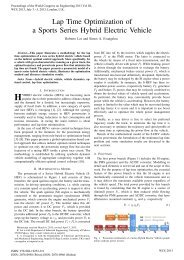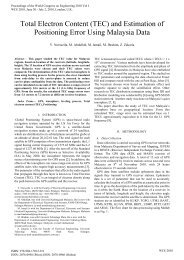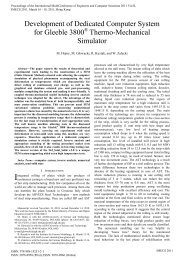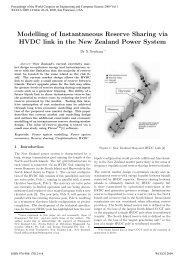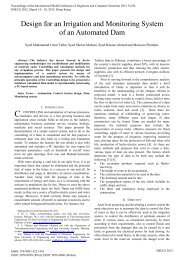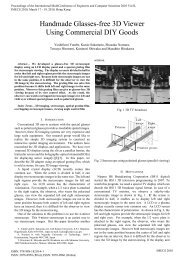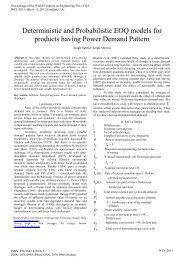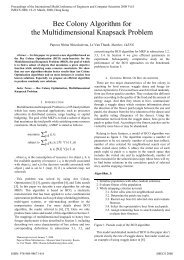Devise of the Reuse System of Chromium Plating Solution and ...
Devise of the Reuse System of Chromium Plating Solution and ...
Devise of the Reuse System of Chromium Plating Solution and ...
You also want an ePaper? Increase the reach of your titles
YUMPU automatically turns print PDFs into web optimized ePapers that Google loves.
Proceedings <strong>of</strong> <strong>the</strong> International MultiConference <strong>of</strong> Engineers <strong>and</strong> Computer Scientists 2008 Vol II<br />
IMECS 2008, 19-21 March, 2008, Hong Kong<br />
<strong>Devise</strong> <strong>of</strong> <strong>the</strong> <strong>Reuse</strong> <strong>System</strong> <strong>of</strong> <strong>Chromium</strong><br />
<strong>Plating</strong> <strong>Solution</strong> <strong>and</strong> Rinse Water in <strong>Chromium</strong><br />
<strong>Plating</strong> Process<br />
J. Chuensakul, <strong>and</strong> P. Kittisupakorn<br />
Abstract—<strong>Reuse</strong> is a technology which more accept in<br />
industry. This system does not only reduce production cost but<br />
also reduce pollution <strong>of</strong> environment. The research is done in<br />
order to study <strong>and</strong> design reused system in electroplate industry<br />
by design reused chromium plating solution <strong>and</strong> rinsed water.<br />
On <strong>the</strong> process, optimize working condition in making<br />
chromium plating solution <strong>and</strong> rinsed water is important factor<br />
that it needs to formulate ma<strong>the</strong>matical model by collect data<br />
from real experiment.<br />
Keywords—electroplating, chromium plating, rinse water,<br />
reuse system, optimization<br />
I. INTRODUCTION<br />
Nowadays, <strong>Reuse</strong> is a technology which more accept in<br />
industry. It brings used resources but remain quality to<br />
process in reuse system. This system does not only reduce<br />
operation cost but also reduce pollution <strong>of</strong> environment.<br />
According to estimated electroplating plants, it found that<br />
most <strong>of</strong> <strong>the</strong>m still have not reused rinse water. Some<br />
electroplating plants have already implemented reused<br />
process but still low st<strong>and</strong>ard quality. Most <strong>of</strong> waste water<br />
occurs in rinsing process since <strong>the</strong>y lack <strong>of</strong> concentration<br />
examination <strong>and</strong> moreover <strong>the</strong>y drain rinse water without<br />
reuse it again.<br />
As above mention, <strong>the</strong> research was done in order to study<br />
<strong>and</strong> design reused system in electroplating industry. This<br />
chapter divides into three parts. First, collect <strong>the</strong> data from<br />
real experiment in electroplating plant. Second, formulate<br />
ma<strong>the</strong>matical model <strong>and</strong> compare with real data. Finally, find<br />
optimize working condition <strong>of</strong> chromium plating solution<br />
<strong>and</strong> rinse water.<br />
II. ELECTROPLATING PROCESS<br />
The research is done in order to study system in nickel -<br />
chromium electroplates industry that will electroplated<br />
machine part by automatically working.<br />
The electroplating process falls into <strong>the</strong> following step.<br />
First step is preparation <strong>and</strong> cleaning a part; such as<br />
polishing, cleaning plated by various chemical; before<br />
electroplates process. Second step is nickel electroplates it<br />
Author is with <strong>the</strong> Control <strong>and</strong> <strong>System</strong>s Engineering Laboratory,<br />
Department <strong>of</strong> Chemical Engineering, Chulalongkorn University, Bangkok<br />
10330, Thail<strong>and</strong>; e-mail: J.Chuensakul@ hotmail.com <strong>and</strong><br />
paisan.k@chula.ac.th).<br />
can maintain <strong>and</strong> protect surface metal. Third step is<br />
chromium electroplates. This step will do a part st<strong>and</strong> for<br />
scrape <strong>and</strong> decay. The last step is drying process.<br />
III. CHROMIUM PLATING<br />
The research is done in order to part dipping part with<br />
chromium <strong>and</strong> rinsing water. By collecting data from<br />
electroplate industry to get <strong>the</strong> result <strong>of</strong> primary parameter<br />
<strong>and</strong> <strong>the</strong>n compare <strong>the</strong> result with ma<strong>the</strong>matic model.<br />
A. Data Collection<br />
<strong>Chromium</strong> electroplating condition will be as following<br />
below ; chromic Acid 215-275 g ⋅ L -1 , temperature 40-45 C.<br />
Time for chromium electroplating 2 minute. Volume <strong>of</strong><br />
chromium electroplating tank 1320 L. <strong>and</strong> rinsing water tank<br />
1100 L.<br />
The working process has electroplated 7200 parts per day.<br />
It has to fill deionization water back into electroplate tank<br />
every 2 days. It is necessary to has chemical solution<br />
overwhelm a part. Because <strong>the</strong> volume <strong>of</strong> chemical has<br />
decrease after electroplated process by stick it on part <strong>and</strong><br />
drag out. Then some area <strong>of</strong> a part cannot electroplate.<br />
Collecting data will take 2 working cycles. A working cycle<br />
is 24 working days. This research will collect <strong>the</strong> data every 2<br />
days. There are collecting chemical solution <strong>and</strong> measure<br />
capacity after electroplated process at chromium<br />
electroplating tank. O<strong>the</strong>r wise it also collecting chemical<br />
solution after fill deionization water up by respectively.<br />
About ab<strong>and</strong>oned tank also collect chemical solution <strong>and</strong><br />
measure capacity <strong>of</strong> electroplating tank after wash out<br />
process.<br />
B. Modeling for electroplating process<br />
Formulate ma<strong>the</strong>matical model <strong>of</strong> original chromium<br />
plating in electroplate industry, reused chromium plating<br />
chemical ma<strong>the</strong>matical model <strong>and</strong> ma<strong>the</strong>matical model <strong>of</strong><br />
rinsed water. To underst<strong>and</strong> <strong>the</strong> process, <strong>the</strong> quality <strong>of</strong><br />
chemical solution from doing material balances model.<br />
Since <strong>the</strong> process is non-reaction, well-mixed, volume <strong>of</strong><br />
rinsing water is constant, drag in <strong>and</strong> drag out are constant<br />
<strong>and</strong> rate <strong>of</strong> evaporation is very less. The initial condition <strong>of</strong><br />
process <strong>and</strong> parameter values has see table 1.<br />
Original for electroplating process. The original<br />
chromium plating ma<strong>the</strong>matical model in electroplate<br />
industry <strong>and</strong> ma<strong>the</strong>matical model <strong>of</strong> rinsing water can<br />
explain by following equation.<br />
ISBN: 978-988-17012-1-3 IMECS 2008
Proceedings <strong>of</strong> <strong>the</strong> International MultiConference <strong>of</strong> Engineers <strong>and</strong> Computer Scientists 2008 Vol II<br />
IMECS 2008, 19-21 March, 2008, Hong Kong<br />
WD<br />
D D D<br />
Fig 1. Original for electroplating process.<br />
Electroplating tank<br />
dVe<br />
= −D<br />
+ WDI<br />
(1)<br />
dt<br />
d( VeZ<br />
e<br />
)<br />
= −DZ<br />
e<br />
− m<br />
(2)<br />
dt<br />
; m = c ⋅ I ⋅t<br />
a<br />
e<br />
⋅<br />
Rinsing tank<br />
dZ D D<br />
r1<br />
= Z<br />
e<br />
− Z<br />
r1<br />
dt Vr1<br />
Vr1<br />
(3)<br />
dZ D D<br />
r 2<br />
= Z<br />
r1<br />
− Z<br />
r 2<br />
dt V V<br />
(4)<br />
r 2<br />
Z<br />
e<br />
r 2<br />
Z<br />
r<br />
Z<br />
r<br />
Table 1.<br />
Initial condition <strong>and</strong> process parameter values.<br />
____________________________________________<br />
Z e (0) = 270.70 g ⋅ L -1<br />
Z r1 (0) = 0 g ⋅ L -1<br />
Z r2 (0) = 0 g ⋅ L -1<br />
V e (0) = 1320 L<br />
V r1 = 1100 L<br />
V r2 = 1100 L<br />
D = 13.28 L ⋅ day -1<br />
W DI = 26.56 L ⋅ day -1<br />
R e = 26.56 L ⋅ day -1<br />
________________________________________________<br />
IV. RESULTS AND DISCUSSIONS<br />
The result <strong>of</strong> comparing among collecting data from<br />
industry, original chromium plating ma<strong>the</strong>matical model,<br />
reused chromium plating ma<strong>the</strong>matical model <strong>and</strong> rinsed<br />
water ma<strong>the</strong>matical model.<br />
<strong>Reuse</strong> for electroplating process. The reused chromium<br />
plating ma<strong>the</strong>matical model will do not fill deionization<br />
water to chromium electroplate tank. But take chemical<br />
solution to reuse from first rinsed tank using for instead. The<br />
process can explain by following equation.<br />
R<br />
e D D D<br />
Fig 3. Concentration <strong>of</strong> chromic acid in<br />
electroplating tank.<br />
Z<br />
e<br />
Z<br />
r<br />
Z<br />
r<br />
Z<br />
r 1<br />
Fig 2. <strong>Reuse</strong> for electroplating process.<br />
Electroplating tank<br />
dVe<br />
= −D<br />
+ Re<br />
(5)<br />
dt<br />
d( VeZ<br />
e<br />
)<br />
= −DZ<br />
e<br />
− m + ReZ<br />
r1<br />
f<br />
(6)<br />
dt<br />
Fig 4. Concentration <strong>of</strong> chromic acid in<br />
first rinsing water.<br />
The part <strong>of</strong> ma<strong>the</strong>matical model <strong>of</strong> rinsing water can use<br />
equation ( 3) <strong>and</strong> (4).<br />
ISBN: 978-988-17012-1-3 IMECS 2008
Proceedings <strong>of</strong> <strong>the</strong> International MultiConference <strong>of</strong> Engineers <strong>and</strong> Computer Scientists 2008 Vol II<br />
IMECS 2008, 19-21 March, 2008, Hong Kong<br />
Fig 5. Concentration <strong>of</strong> chromic acid in<br />
second rinsing water.<br />
From Fig 3 has found that concentration <strong>of</strong> chromic<br />
acid will decrease when more working time. More<br />
decreasing when fills deionization water or chemical solution<br />
from first rinsed tank. The result from original chromium<br />
plating ma<strong>the</strong>matical model has result similar to data that<br />
collect from industry. From comparing with reused<br />
chromium plating ma<strong>the</strong>matical model has found that <strong>the</strong><br />
concentration <strong>of</strong> chromic acid will decreases less than<br />
original chromium plating ma<strong>the</strong>matical because reusing <strong>of</strong><br />
chemical solution.<br />
From Fig 4 <strong>and</strong> 5 has found that <strong>the</strong> concentration <strong>of</strong><br />
chromic acid in first rising water <strong>and</strong> second rising water<br />
under original chromium plating ma<strong>the</strong>matical model <strong>and</strong><br />
reused chromium plating ma<strong>the</strong>matical model will increase<br />
when working time increase. While <strong>the</strong> result <strong>of</strong> first rinsing<br />
water <strong>and</strong> second rinsing water under original chromium<br />
plating ma<strong>the</strong>matical model has result similar to data <strong>the</strong><br />
collect from industry. From comparing <strong>of</strong> first rinsing water<br />
<strong>and</strong> second rinsing water under reused chromium plating<br />
ma<strong>the</strong>matical model has found that <strong>the</strong> concentration <strong>of</strong><br />
chromic acid first rinsing water <strong>and</strong> second rinsing water<br />
under reused chromium plating ma<strong>the</strong>matical model will<br />
increase than first rinsing water <strong>and</strong> second rinsing water<br />
under original chromium plating ma<strong>the</strong>matical model.<br />
According to concentration <strong>of</strong> chromic acid in reused<br />
chromium electroplating is higher than original chromium<br />
electroplating.<br />
And from economics analyzed, reused chemical solution<br />
in chromium electroplating can decrease operation cost to<br />
28,170.78 THB per year when compare with original<br />
chromium electroplating, see table 2.<br />
Table 2.<br />
Economics analyzed operation cost<br />
____________________________________________<br />
Electroplating process<br />
______________________<br />
Original <strong>Reuse</strong><br />
________________________________________________<br />
Deionization water a (L ⋅ year -1 ) 3,823.72 0.00<br />
Chromic acid b (kg ⋅ year -1 ) 929.16 742.20<br />
Total operation cost (TH ⋅ year -1 ) 117, 234.78 89,064.00<br />
________________________________________________<br />
a, b Deionization water is cost 1.50 THB ⋅ L -1 <strong>and</strong> chromic acid is cost 120<br />
THB ⋅ kg -1<br />
V. OPTIMIZATION<br />
From <strong>the</strong> study in electroplates plant, it found that high<br />
concentration chromic acid <strong>of</strong> electroplating tank stick it on<br />
drag out occurring <strong>the</strong> most amount. It makes concentration<br />
<strong>of</strong> chromic acid is high unnecessarily so optimizing method<br />
will be used in finding optimize working process.<br />
The objective function is formulated to minimize<br />
concentration chromic acid to lost stick it on drag out. The<br />
drag out, D, is <strong>the</strong> decision variable.<br />
The optimization have been processing under<br />
ma<strong>the</strong>matical model constrains <strong>and</strong> limitations <strong>of</strong> minimum,<br />
maximum concentration.<br />
Min F = Z D<br />
(5)<br />
D<br />
e<br />
dVe<br />
Subject to = −D<br />
+ WDI<br />
(6)<br />
dt<br />
d( VeZ<br />
e<br />
)<br />
= −DZ<br />
e<br />
− m<br />
(7)<br />
dt<br />
dZ D D<br />
r1<br />
= Z<br />
e<br />
− Z<br />
r1<br />
dt Vr1<br />
Vr1<br />
(8)<br />
dZ D D<br />
r 2<br />
= Z<br />
r1<br />
− Z<br />
r 2<br />
dt Vr<br />
2<br />
Vr<br />
2<br />
(9)<br />
0 ≤ D ≤ 15<br />
(10)<br />
215 ≤ Z ≤ 275<br />
(11)<br />
e<br />
Working process will take in 1 cycle working. By finding<br />
optimal volume <strong>of</strong> drag out when vary initial concentration <strong>of</strong><br />
chromic acid in electroplating tank.<br />
Fig 6. Comparing concentration <strong>of</strong> chromic<br />
acid in electroplating tank.<br />
ISBN: 978-988-17012-1-3 IMECS 2008
Proceedings <strong>of</strong> <strong>the</strong> International MultiConference <strong>of</strong> Engineers <strong>and</strong> Computer Scientists 2008 Vol II<br />
IMECS 2008, 19-21 March, 2008, Hong Kong<br />
VI. CONCLUSION<br />
This paper is done to study electroplating plant working by<br />
formulating ma<strong>the</strong>matical model, designing working process<br />
<strong>and</strong> finding optimize condition that conclude as following.<br />
This ma<strong>the</strong>matical model is acceptable because its result<br />
similar to experiment from electroplating plant.<br />
To design reused chemical solution in chromium<br />
electroplating can decrease operation cost in part chromic<br />
acid <strong>and</strong> deionization water.<br />
Working operation in electroplating plant will be initial<br />
concentration chromic acid 269.970 g ⋅ L -1 <strong>and</strong> drag out<br />
13.1139 L.<br />
Fig 7. Comparing concentration <strong>of</strong> chromic<br />
acid in first rinsing water.<br />
Fig 8. Comparing concentration <strong>of</strong> chromic<br />
acid in second rinsing water.<br />
From Fig 6, 7 <strong>and</strong> 8 <strong>the</strong> result <strong>of</strong> comparing among<br />
original chromium plating ma<strong>the</strong>matical model, optimum<br />
volume <strong>of</strong> drag out chromium plating <strong>and</strong> rinsed water. It<br />
found that to decrease amount concentration chromic acid<br />
stick it on drag out <strong>and</strong> concentration chromic acid <strong>of</strong> rinsing<br />
water. Which optimal volume <strong>of</strong> drag out 13.1139 L <strong>and</strong><br />
initial concentration chromic acid 269.970 g ⋅ L -1<br />
APPENDIX<br />
Z e concentration <strong>of</strong> chromic acid in electroplating tank<br />
(g ⋅ L -1 )<br />
Z r1 concentration <strong>of</strong> chromic acid in rinsing water tank 1<br />
(g ⋅ L -1 )<br />
Z r2 concentration <strong>of</strong> chromic acid in rinsing water tank 2<br />
(g ⋅ L -1 )<br />
Z r1f final concentration <strong>of</strong> chromic acid in rinsing water tank<br />
1 (g ⋅ L -1 )<br />
V e volume <strong>of</strong> chromium electroplating tank (L)<br />
V r1 volume <strong>of</strong> rinsing water tank 1 (L)<br />
V r2 volume <strong>of</strong> rinsing water tank 2 (L)<br />
D drag out volume (L ⋅ day -1 )<br />
W DI volume <strong>of</strong> deionization water to fill into electroplating<br />
tank (L ⋅ day -1 )<br />
R e volume <strong>of</strong> solution in rinsing water 1 to reuse into<br />
electroplating tank (L ⋅ day -1 )<br />
m amount <strong>of</strong> chromium deposited at <strong>the</strong> cathode (g ⋅ day -1 )<br />
c faraday constant <strong>of</strong> chromium (0.3234 g ⋅ A -1 ⋅ hr -1 )<br />
I current that flows through <strong>the</strong> electroplating tank<br />
(A ⋅ day -1 )<br />
a current efficiency (%)<br />
t e time <strong>of</strong> soaking electroplating tank (hr)<br />
Initial concentration <strong>of</strong> chromic acid<br />
(g/L)<br />
280<br />
275<br />
270<br />
265<br />
260<br />
255<br />
250<br />
245<br />
240<br />
235<br />
0 2 4 6 8 10 12 14 16<br />
Optimal volume <strong>of</strong> drag out (L)<br />
Fig 9. Optimum volume <strong>of</strong> drag out.<br />
From Fig 9 <strong>the</strong> optimum volume <strong>of</strong> drag out is<br />
limited in feasible areas. The optimum volume <strong>of</strong> drag out<br />
directly varies with initial concentration chromic acid <strong>the</strong><br />
same proportion. And electroplates plant can working<br />
process initial concentration chromic acid range<br />
269.97-275.00 g ⋅ L -1 . Because limit time <strong>of</strong> fill chromic acid.<br />
ACKNOWLEDGMENT<br />
The financial support to this work through local graduate<br />
scholarship from <strong>the</strong> Thail<strong>and</strong> research fund (TRF) is<br />
gratefully acknowledged.<br />
REFERENCES<br />
[1] H. L. Pinkerton, “Electroplating Engineering H<strong>and</strong>book,”<br />
Pennsylvania Chemical Society, New York, 1995.<br />
[2] E. Langford, “Analysis <strong>of</strong> Electroplating <strong>and</strong> Related <strong>Solution</strong>,”<br />
Birmingham, 1971.<br />
[3] A. Laitinen, “Chemical Analysis,” University <strong>of</strong> Illinois, 1960.<br />
[4] S.L. Lo, <strong>and</strong> Y.C. Tsao. “Economic Analysis <strong>of</strong> waste Minimization for<br />
Electroplating Plants,” Water Sci, 1997, p. 383.<br />
[5] M. Schlesinger, <strong>and</strong> M. Paunovic. “Modern Electroplating,” Wiley,<br />
New York, 2000.<br />
[6] R. Arun, F. Robert, <strong>and</strong> A. Jody. Cadmium <strong>and</strong> <strong>Chromium</strong> recovery<br />
from electroplating Rinsewater. Research <strong>and</strong> development, United<br />
Stated Environment Protection Agency, 1994.<br />
[7] K. Kiptoo, J. Ngila, <strong>and</strong> M. Sawula . Speciation studies <strong>of</strong> nickel <strong>and</strong><br />
chromium in wastewater from an electroplating plant. University <strong>of</strong><br />
Botswana, Botswana, 2004.<br />
[8] Y.H. Yang, H.H. Lou, <strong>and</strong> Y.L. Huang. Syn<strong>the</strong>sis <strong>of</strong> an optimal<br />
wastewater reuse network. Wayne State University, USA, 1999.<br />
ISBN: 978-988-17012-1-3 IMECS 2008
Proceedings <strong>of</strong> <strong>the</strong> International MultiConference <strong>of</strong> Engineers <strong>and</strong> Computer Scientists 2008 Vol II<br />
IMECS 2008, 19-21 March, 2008, Hong Kong<br />
[9] K.Q. Luo, <strong>and</strong> Y.L. Huang. Intelligent Decision Support for Waste<br />
Minimization in Electroplating Plants. Wayne State University, USA,<br />
1997.<br />
[10] Z. Buczko. The modeling <strong>of</strong> a rinsing process in electroplating. The<br />
chemical Engineering Journal, vol. 49, 1992, p. 161–166.<br />
[11] B. Goers, J. Mey, <strong>and</strong> G. Wozny. Optimised product <strong>and</strong> water<br />
recovery from batch – production rinsing waters. Technical University<br />
<strong>of</strong> Berlin, Germany, 2000.<br />
[12] Q. Xu, A. Telukdarie, H. Lou, <strong>and</strong> Y. Huang. Integrated electroplating<br />
system modeling <strong>and</strong> simulation for near zero discharge <strong>of</strong> chemicals<br />
<strong>and</strong> metals.Wayne St State University, USA, 2005.<br />
ISBN: 978-988-17012-1-3 IMECS 2008


